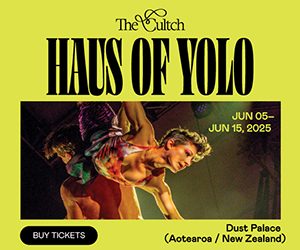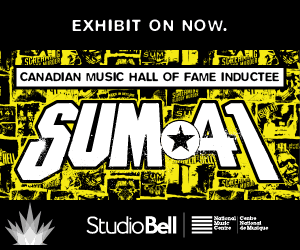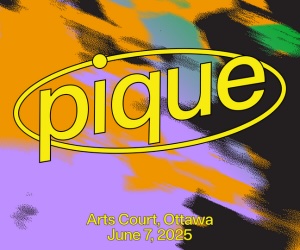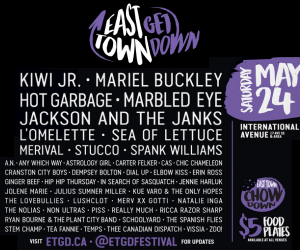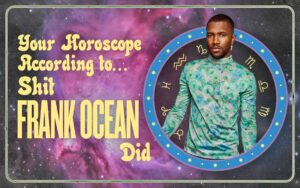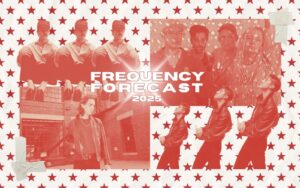Half Moon Run Summon Visions of the Past
Conner Molander reflects on the band’s early days in Montreal and trusting the process of spontaneity after two decades.
by Stephan Boissonneault
By Gaëlle Leroyer
- Published on
While recording their fourth full-length album, Salt, the members of Half Moon Run were feeling a touch nostalgic. Producer Connor Seidel requested absolutely every demo they had ever worked on. Diving into their archives, they not-so-surprisingly found song ideas, fully-fleshed out songs, and voice recordings—mostly recorded on their old two-track Tascam recorder that they travel everywhere with. Some of these demos were close to 15-years-old, when the three core members were just kids. Multi-instrumentalist Conner Molander gets a bit sentimental when talking about the process, remembering the days when the band was still cutting their teeth and practicing—almost daily—at Montreal’s now shuttered DIY rehearsal space and afterparty spot, the Torn Curtain.
“It’s funny when you crack open a song from that era; all the memories just flood in,” Molander says, talking to RANGE from Parc Jarry in Montreal on a hot summer day. “It was the smell. I remembered the smell of the Torn Curtain, the old beer bottles, the musty kind of industrial smell. The bagels and chickpea salad ‘cause we had no money—just the good ol’ days.”
Molander, and his bandmates, lead singer Devon Portielje, and drummer/keyboardist Dylan Phillips, also had time to “rediscover” the bubbling chemistry they experienced during their Torn Curtain era. They would bike over to the space and stay there for hours, writing music as a three-piece, learning how to be a band, with no realized dream of future success. They never envisioned winning a Juno for their 2019 third full-length, A Blemish in the Great Light. “We definitely had aspirations, but during those days, we were just meeting up every day to make music because we loved it,” he says. “We also weren’t really part of the scene. I mean, we were physically there, but we weren’t hanging out. We would lock ourselves away for 10 hours while artists like Cop Car Bonfire and Grimes were doing their thing.”
Half Moon Run has always been an insular unit of creativity, but recently they have started to branch out by meeting other artists to potentially collaborate with. This is partly thanks to Connor Seidel’s Montreal artist-focused 1969 compilation, a concept album of all original music dedicated to the late 60s and featuring an incredible lineup of Canadian artists including Moffatt, Safia Nolin, Half Moon Run, Claudia Bouvette, and Elisapie. “That was cool because we actually got to meet everyone for the first time,” Molander says.
Salt is the first Half Moon Run album to feature live string arrangements, (from Montreal’s premiere string quartet, Quatuor Esca), an undeniable highlight on the new album, elevating songs like “Alco,” “Hotel in Memphis,” and “Dodge and Rubble.” Both Phillips and Molander usually take a crack at the arrangements because they have some classical training, but Molander says Half Moon Run owes a lot of it to a musician named Antoine Gratton.
“He has a really wacky style, very stream of consciousness, and he’ll write way more stuff than he knows we are going to use,” Molander says of the composer/multi-instrumentalist. “So lots of the arrangements were cut and pasting and chopping stuff up from these charts he was giving us, which gave this very stylistic sound collage vibe. Personally I love it.”
Another stream of consciousness song comes from Salt’s opener “You Can Let Go.” The track’s verses have a very melancholic vibe to it, existing on its own plane in a more Radiohead-esque space than Half Moon Run is known for. When it came to record it, the music was already written and the anthemic chorus was something the band was happy with for a while, but the verses were blank. It was up to Portielje to come up with something on the spot.
“It can be dangerous to leave the lyrics that late. But we told Dev to just go in the hallway and give it a shot,” Mollander says. “He came back and was really excited and said ‘I’m going to try something different,’ and he just started doing that completely different style of underground UK style singing and we were just blown away.”
During that same session, Molander and Phillips encouraged Portielje to go further with his new lyrical vision. “We said ‘Keep going this is so good, really lean into it’ and he did and it being such a stark contrast to our music, we decided it should be the first song. Sort of as a statement.”
Even with bands 20 years in, that kind of magical spontaneity is sometimes muted, but not for Half Moon Run. And that kind of trust in a band doesn’t just happen overnight. “Thinking about it now, it reminds me of when we first started doing it during those Torn Curtain days. We trusted each other and found each other’s potential and man, we still are.”
By Stephan Boissonneault
In a wistful one-shot video the Montreal-based songwriter traverses dream pop terrain and emotional crossroads.
By Glenn Alderson
The Vancouver-based artist kicks off a new era with a slow-burning R&B ballad pulled from her upcoming EP Product of Loneliness.




